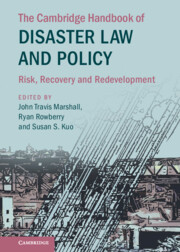Book contents
- The Cambridge Handbook of Disaster Law and Policy
- The Cambridge Handbook of Disaster Law and Policy
- Copyright page
- Dedication
- Contents
- Figures
- Maps
- Tables
- Contributors
- Foreword: Current Trends in Disaster Law and Policy
- Acknowledgments
- Introduction
- Part I Critical Perspectives on the Evolution of Disaster Law and Policy
- Part II Effective Governance as an Imperative for Responsive Disaster Law and Policy
- Part III Law’s Role in Promoting Hazard Mitigation: Intergovernmental, International, National, and Local Approaches
- Part IV Private Sector Initiatives to Promote Disaster Resilience and Recovery
- Part V Lawyers As Disaster Law and Policy Leaders: Training for Students and Guidance for Practitioners
- Part VI Cultural Heritage Protection and Cross-Disciplinary Opportunities for Advancing Disaster Law and Policy
- Part VII Disasters and Vulnerable Communities
Introduction
Published online by Cambridge University Press: 27 October 2022
- The Cambridge Handbook of Disaster Law and Policy
- The Cambridge Handbook of Disaster Law and Policy
- Copyright page
- Dedication
- Contents
- Figures
- Maps
- Tables
- Contributors
- Foreword: Current Trends in Disaster Law and Policy
- Acknowledgments
- Introduction
- Part I Critical Perspectives on the Evolution of Disaster Law and Policy
- Part II Effective Governance as an Imperative for Responsive Disaster Law and Policy
- Part III Law’s Role in Promoting Hazard Mitigation: Intergovernmental, International, National, and Local Approaches
- Part IV Private Sector Initiatives to Promote Disaster Resilience and Recovery
- Part V Lawyers As Disaster Law and Policy Leaders: Training for Students and Guidance for Practitioners
- Part VI Cultural Heritage Protection and Cross-Disciplinary Opportunities for Advancing Disaster Law and Policy
- Part VII Disasters and Vulnerable Communities
Summary
“The greatest comeback since Lazarus” is how Peter Ricchiuti, Assistant Dean of Tulane’s Business School, often described New Orleans’ recovery from Hurricane Katrina’s near-total devastation. In the years immediately following Katrina, Ricchiuti frequently welcomed students, graduates, and business professionals to New Orleans. Seeing visitors and newcomers amazed and inspired him, his colleagues, and his neighbors. Outside the Central Business District hotels where he often spoke at conferences, there were scores of shops, restaurants, and offices reopening for business, undeterred by vacant office towers and the lingering odor of basements still damp and moldy from floodwaters. A little farther away, across dozens of city neighborhoods, thousands of residents and volunteers were slowly rebuilding homes, businesses, and churches submerged for weeks following Katrina’s catastrophic levee breaches. For those who had observed firsthand New Orleans’ near-complete devastation, its resurgence was solemn and awe-inspiring.
- Type
- Chapter
- Information
- The Cambridge Handbook of Disaster Law and PolicyRisk, Recovery, and Redevelopment, pp. 1 - 22Publisher: Cambridge University PressPrint publication year: 2022

